Would you like help deciding which version of a page will work best for your business? Thrive Optimize, a plugin built as an addon for Thrive Architect will help you track and decide what works best with your audience.
In this article, we’ll see how you can create an A/B test for pages and use Thrive Optimize to pick the winning version.
Note: Before using Thrive Optimize, please ensure you’ve created a version of your page using Thrive Architect.
- Cloning a Page for A/B Testing
- Understanding the A/B Test Dashboard
- Setting up a Goal for an A/B Test
- Understanding the Thrive Optimize Dashboard
- Viewing Particular Test Results
- Stopping an A/B Test and Choosing a Winner Manually
- Frequently Asked Questions About Thrive Optimize
Cloning a Page for A/B Testing
An A/B test can be used to track which page works best with your audience. With Thrive Optimize, you can clone pages created using Thrive Architect to edit and A/B test the variations.
To A/B test pages, start by cloning a page in Thrive Architect.
Before we begin, please ensure you have the final page designed and ready using Thrive Architect.
To clone the created page, open your WordPress admin area, navigate to Pages >> All Pages, and click the Edit with Thrive Architect link seen when you hover on the page name.

In the Thrive Architect editor, click on A/B in the right panel.
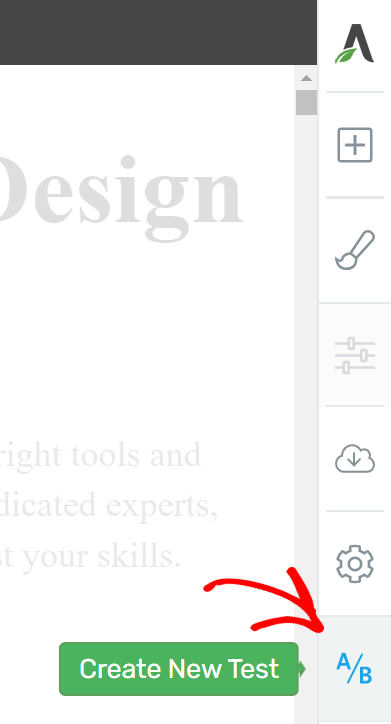
When you click to Create a new test, you’ll be taken to a dashboard where you can manage all the pages included in the test.
On this dashboard, you can click Add new Variation to create a new page you’d like to compare with the existing page.

If you want to create a copy of the existing page and modify it, click on the copy icon to Duplicate the existing page.
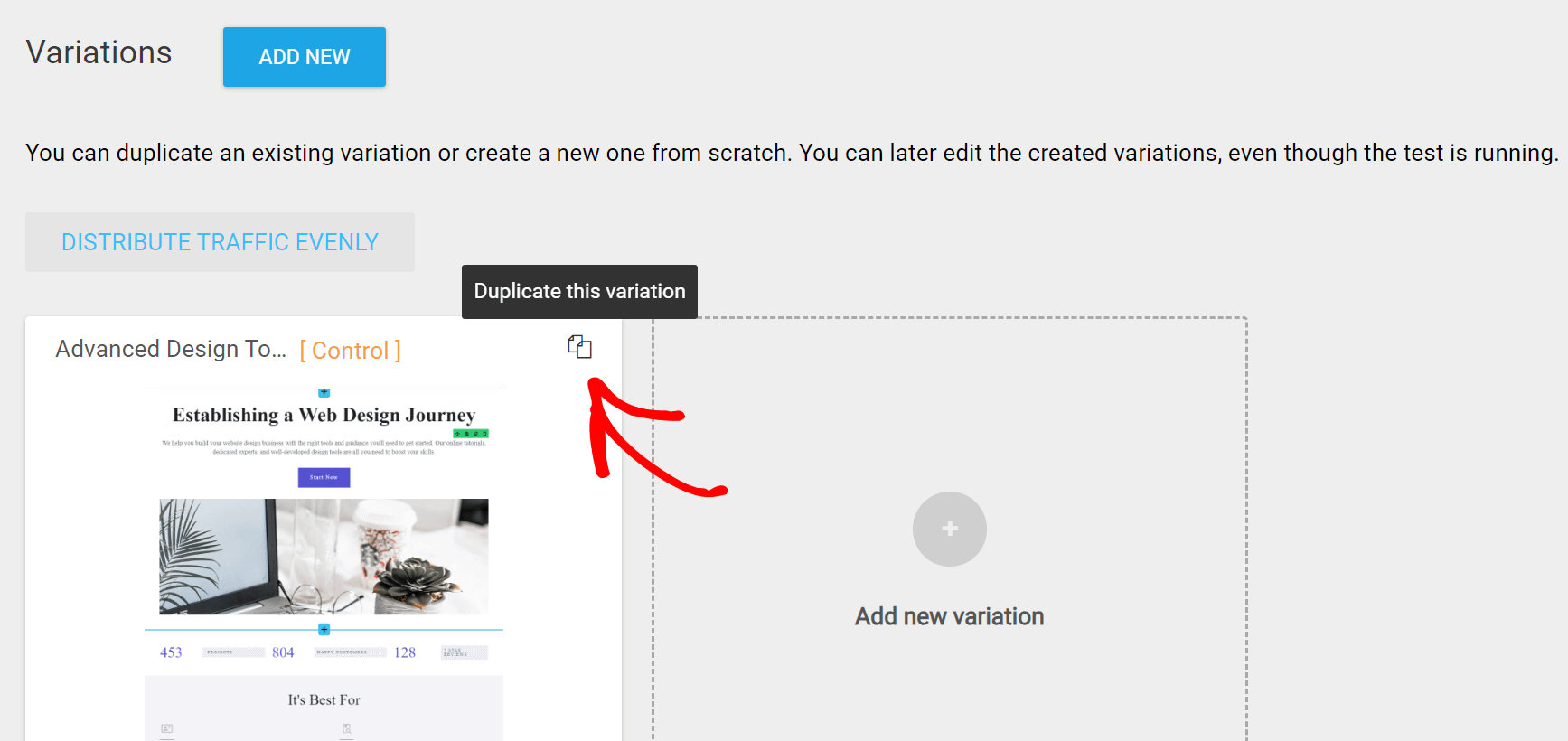
When you click the duplicate icon, you’ll see a copy of the page created in the dashboard. You can edit the name of the variation by clicking the pen icon beside the temporary name given to it.

After creating and naming the variation, hover over it and click the Edit Variation button.
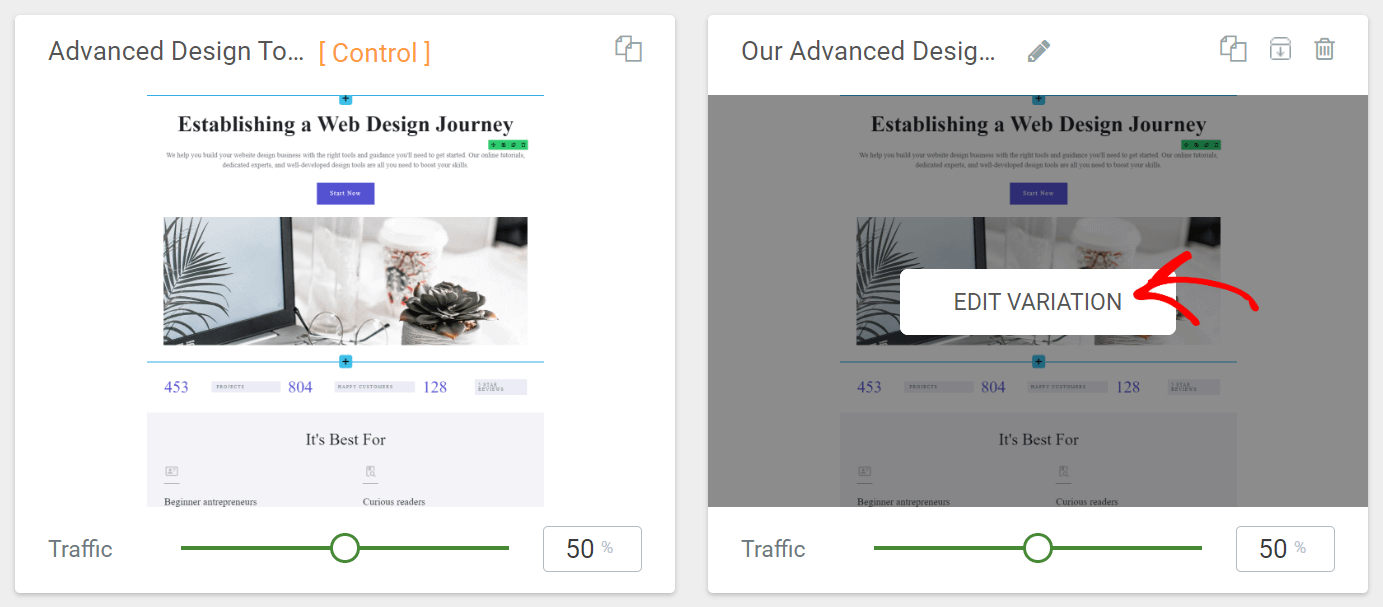
When you click Edit Variation, the newly created page will be opened in the Thrive Architect editor. This is where you can modify the page as per your needs.
For example, let us change the colors used for the calls-to-action on the page. This will help understand what colors work best to grab user attention. Adding, removing, or editing elements can be done quickly using Thrive Architect.

After editing the page, click Save Work on the bottom left of the screen.
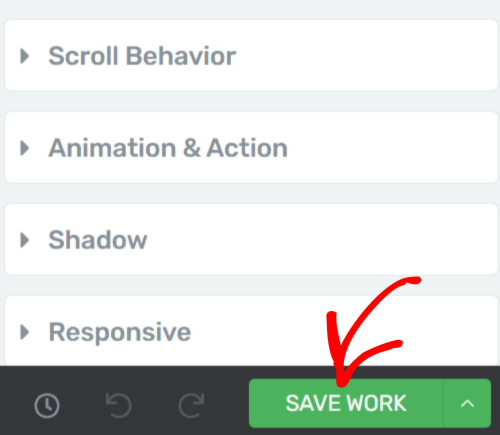
Understanding the A/B Test Dashboard
After creating a clone and making the necessary changes, you can return to the A/B testing dashboard by clicking A/B in the right panel in the Thrive Architect editor.

The A/B test dashboard lets you distribute traffic among the variations and manage other page settings.
Distributing traffic among variations
To distribute traffic among variations, use the slider on each variation to determine the percentage of traffic you want it to cater to.
The traffic will accordingly be distributed among all the available variations.

Accessing parent page settings
The A/B test dashboard lets you access the parent page quickly by clicking the Page Settings option in the top bar.
Clicking Page Settings will open the parent page in the WordPress page editor.

Setting up and starting the A/B test
To set up and start the A/B test, click the Set up and Start A/B test option on the right in the top bar.

When you click the Set up and Start A/B Test, you’ll see a popup with two tabs: Personalize your A/B test and Set the test goal.

Under the tab to Personalize your A/B test, you can add test details like the name and description and enable settings to determine a winner automatically.
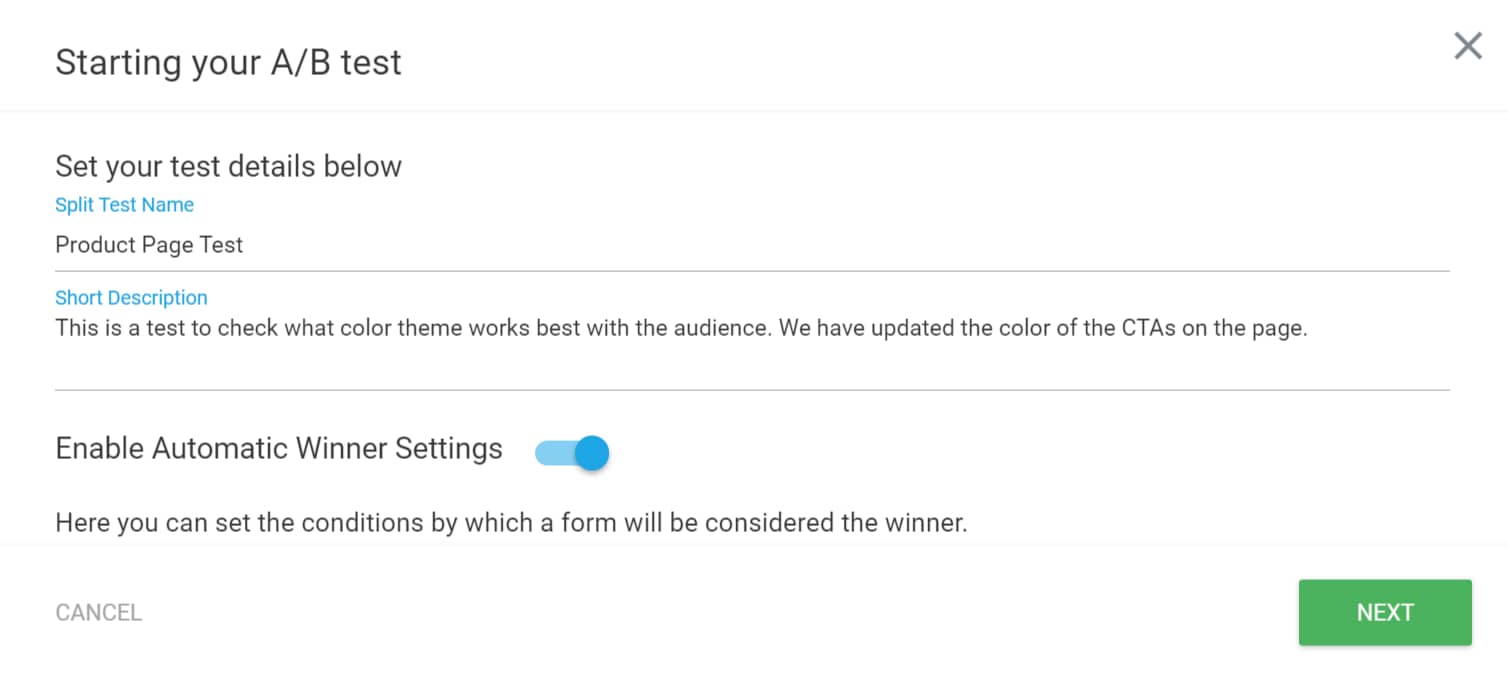
When you enable the settings to determine a winner automatically, you can set conditions to help determine the winner.
The conditions are:
- Minimum conversions: The number of minimum conversions the variation should attract.
- Minimum duration: The days you want the test to determine the winner.
- Chance to beat original: The percentage of conversions you want a variation to cross compared to the original page.
After personalizing the test, click the Next button on the bottom right of the popup.

When you click Next, it’ll take you to the next tab where you can set the Goal of the test.
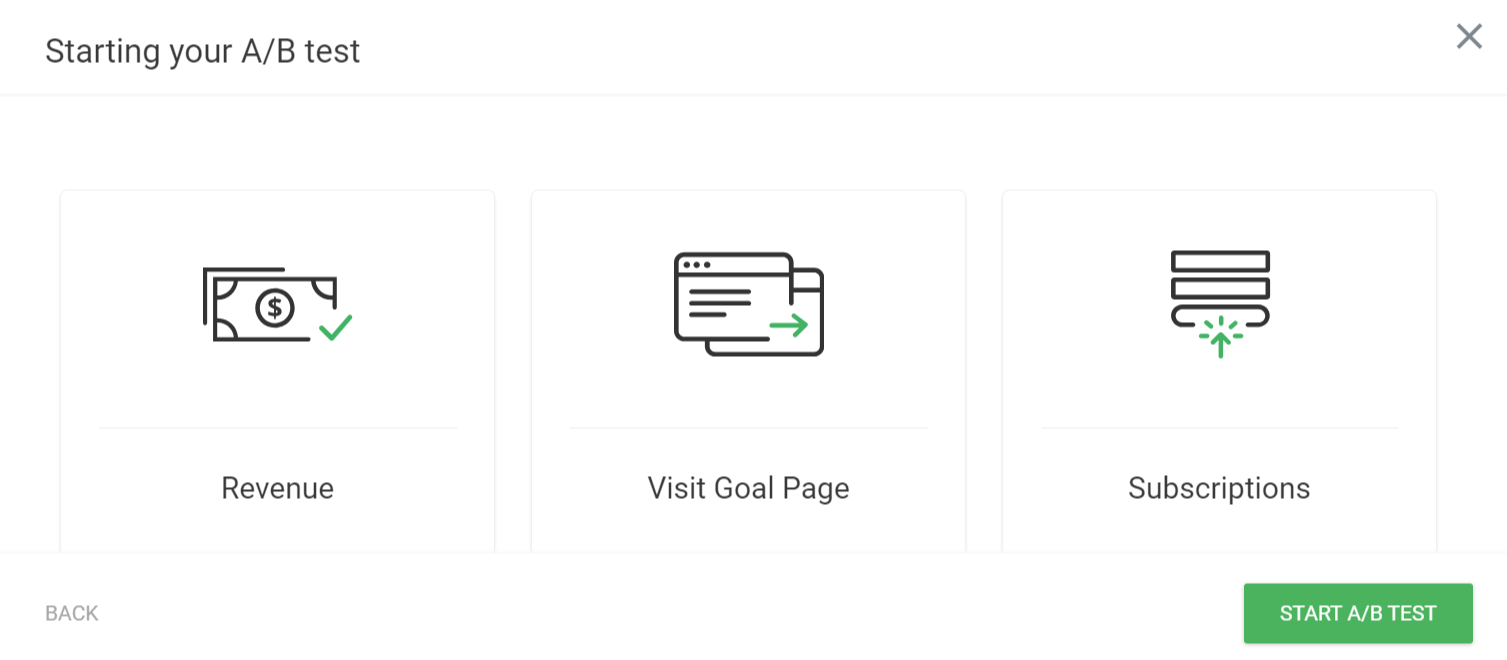
To know more about test goals, refer to this section in the document.
After setting a test goal, click the Start A/B Test button on the popup.
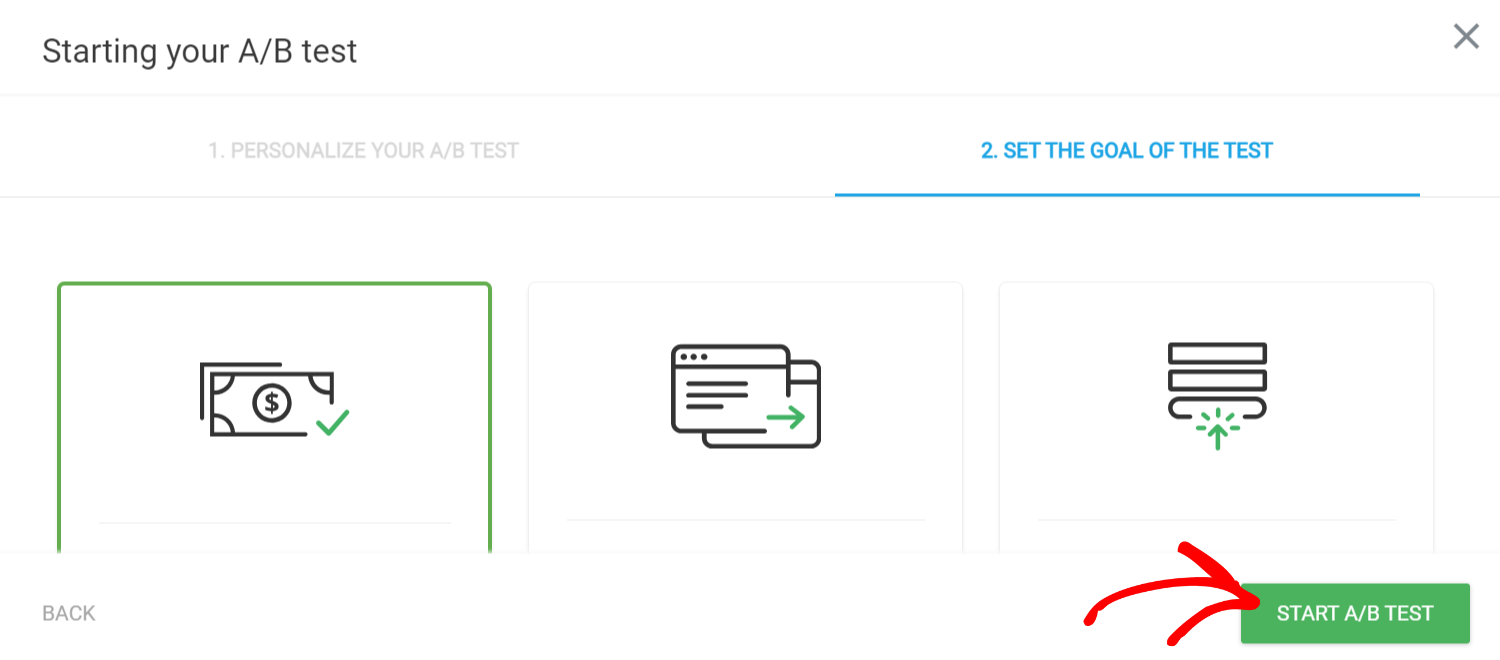
Clicking the button will start the test on your website.
Setting up a Goal for an A/B Test
A goal is the outcome you’d want from your website visitors.
An A/B test will let you set a goal you’d want to achieve with the created variations. This will help determine a winner based on the outcome.
To set a goal for your A/B test, open the A/B test dashboard as mentioned in the step here.
You can add a goal in the second tab in the Set up and Start A/B test popup. You can open this popup by clicking the Set up and Start A/B test option on the screen’s top right in the A/B test dashboard.

After personalizing the test in the first tab, click the Next button on the bottom right of the popup.

When you click Next, it’ll take you to the next tab where you can set the Goal of the test.

There are three Goal options you’ll see in this tab. They are as follows.
- Revenue: This option will allow you to select a thank you page and the corresponding conversion value for your business that you’d like to mark. For example, the goal will be marked when one of the variations crosses the set value as revenue.
This goal will let you search for an existing Thank You page to be used here or allow you to create a new one using Thrive Architect by clicking the Add new Thank You page option.
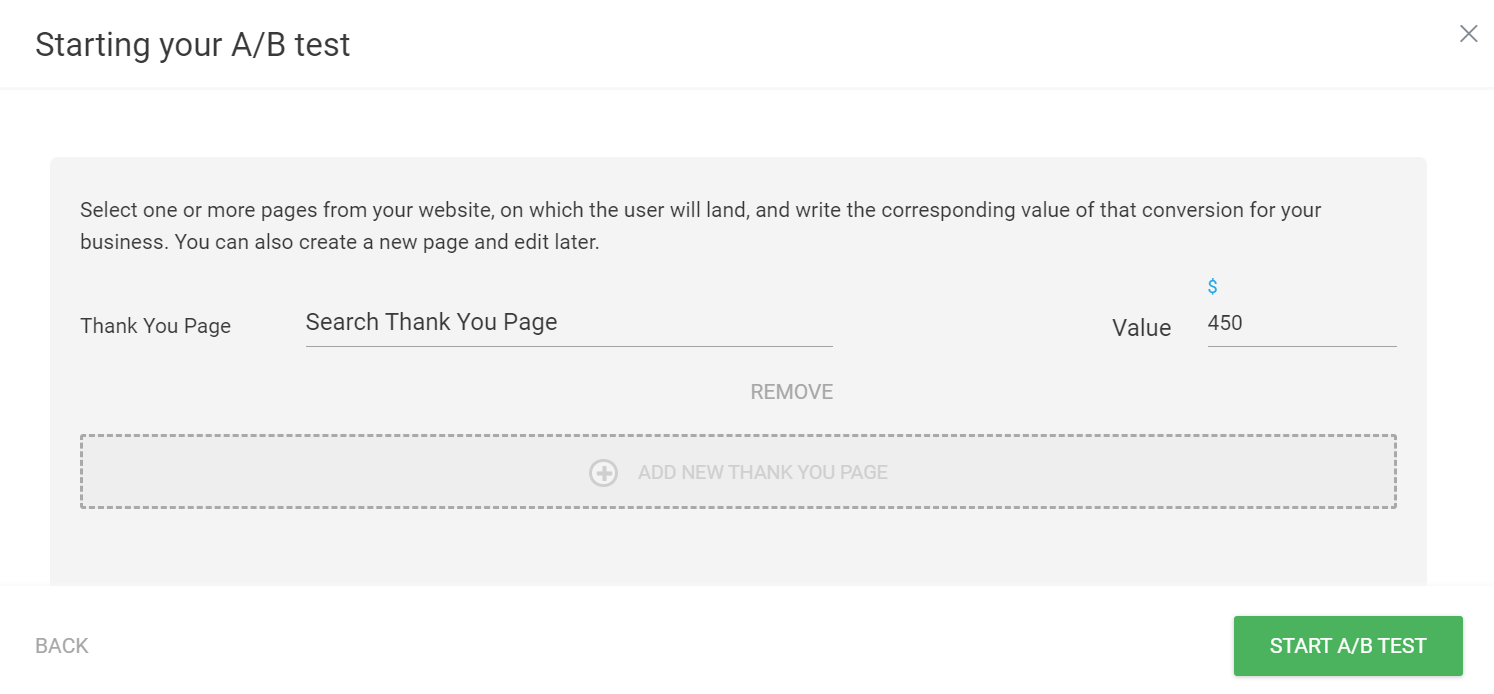
- Visit Goal Page: This will allow you to select a goal page you’d like your audience to reach. The page variation that will bring the maximum number of customers to the goal page will be declared the winner.
You can search for an already created page, edit it, or create a new page by clicking the Add New Goal Page option.
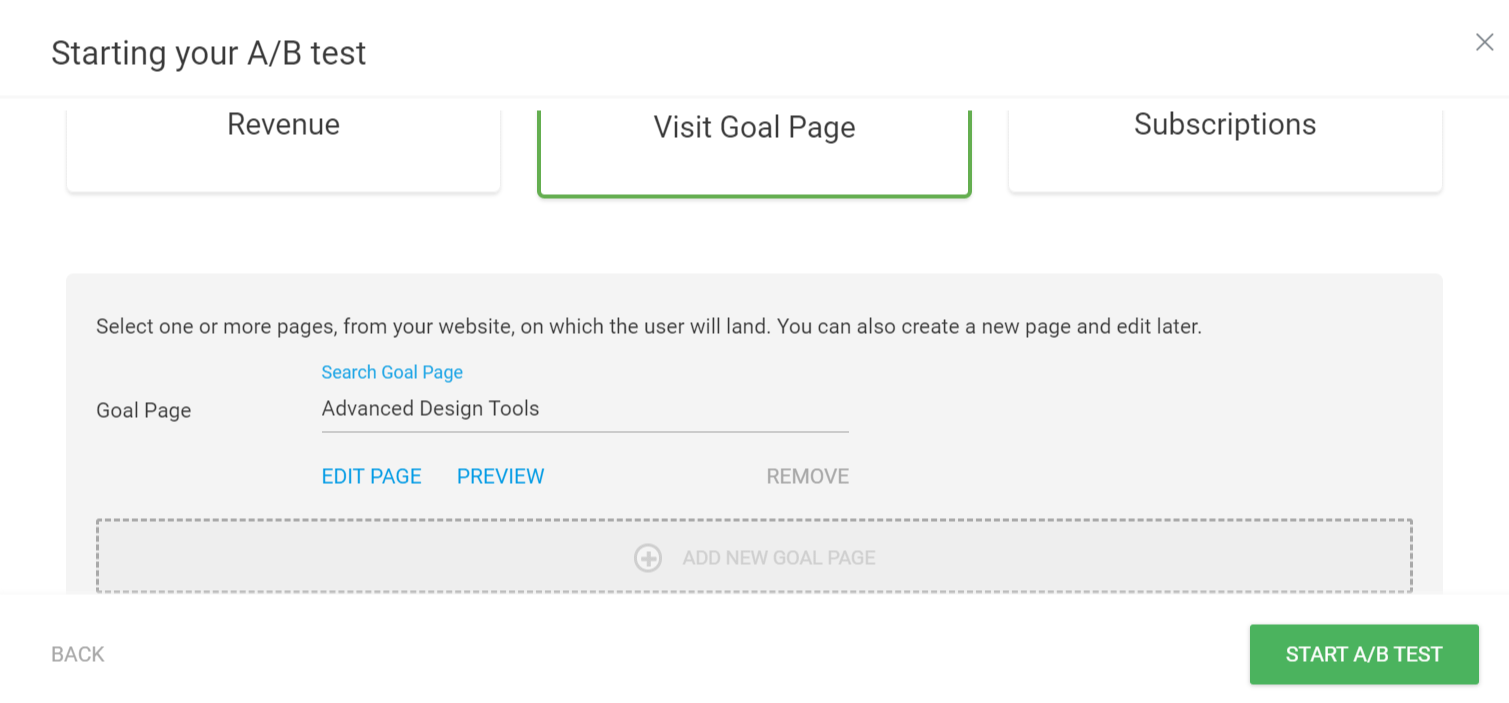
- Subscriptions will allow you to track subscriptions obtained through a lead generation form created using Thrive Leads.
To enable the subscription goal, you must have at least one lead generation form on the variations.
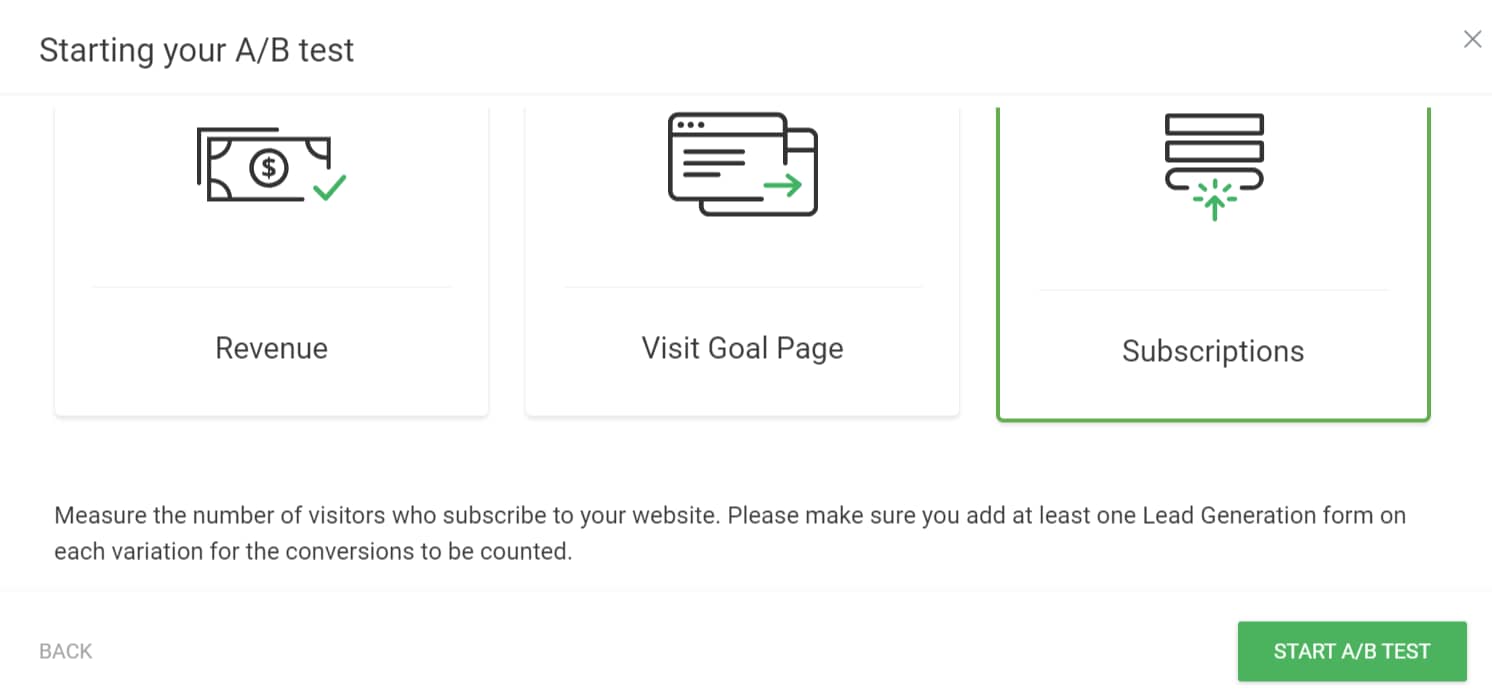
Understanding the Thrive Optimize Dashboard
The Thrive Optimize dashboard is where you’ll see all the statistics of A/B tests and a list of running and completed tests.
To access the Thrive Optimize dashboard, open your WordPress admin area and navigate to Thrive Dashboard >> Thrive Optimize.
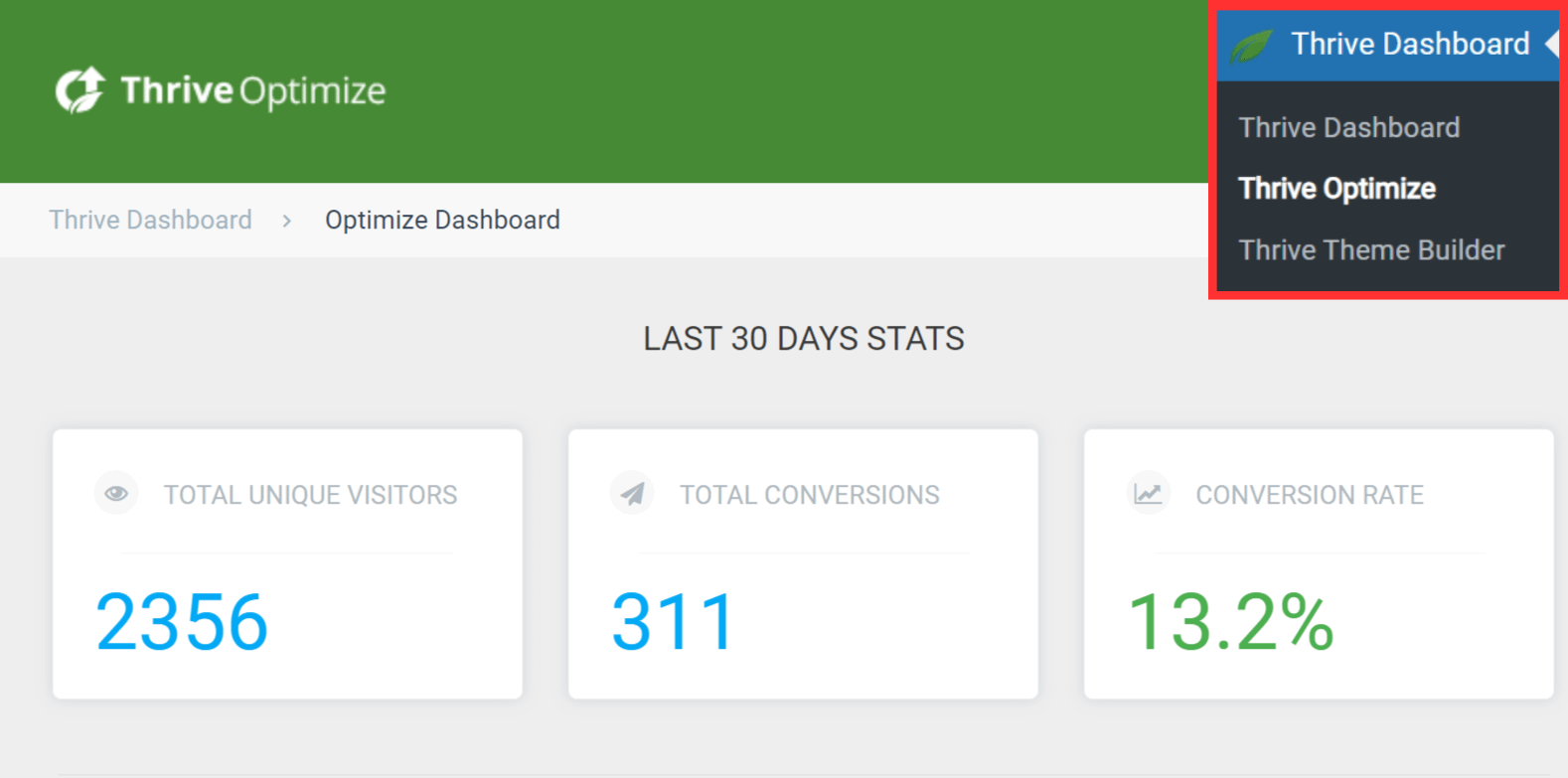
The first section in the dashboard has three blocks, viz., Total unique visitors, Total conversions, and Conversion rate in the past 30 days.
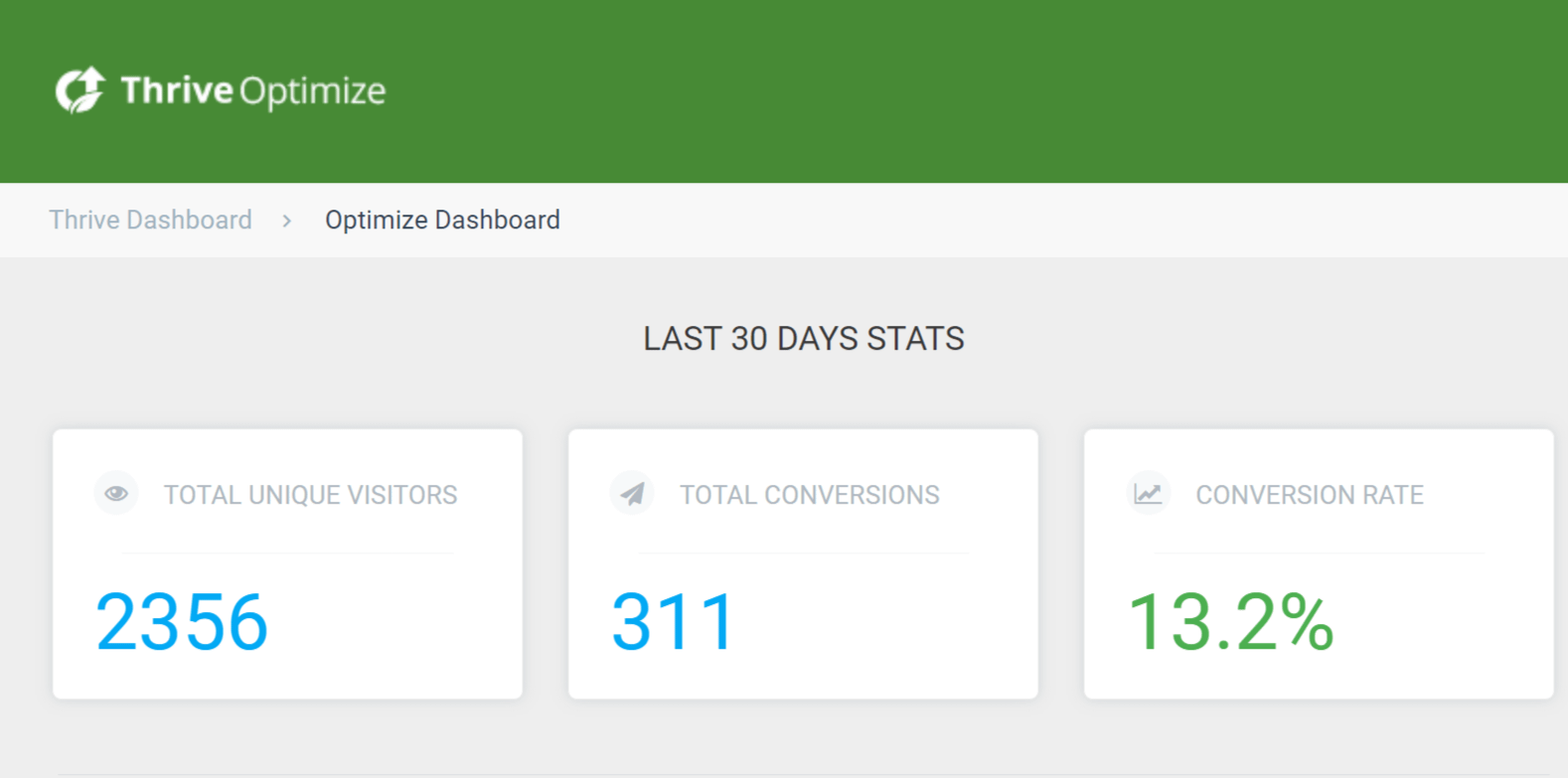
Below the traffic and conversion statistics, you’ll see two tables with a list of Running A/B tests and Completed A/B tests.
Under the Running A/B tests table, you’ll see columns such as
- Test Name: The name you assign the test while creating it.
- Date Started: The date when the test is pushed live.
- On Page: The page in consideration, i.e., the control or original page.
- Test Goal: The goal set for this test.
- Unique Visitors: Number of unique visitors on the variation pages of this test
- Conversions: Total conversions obtained from this test
- Actions: This is where you can view the test details.

The Completed A/B test table lists all the A/B tests that have been completed. Here are the columns in this table:
- Test Name: The name you assign the test while creating it.
- End Date: The date when the test is pushed live.
- On Page: The page in consideration, i.e., the control or original page.
- Test Goal: The goal set for this test.
- Actions: This is where you can view the test details.

Viewing Particular Test Results
While the Thrive Optimize Dashboard gives a deeper look into the statistics of all the tests, you can view a single test result to know how it’s going.
To view test details, open your WordPress admin area and navigate to Pages >> All Pages.
Under All Pages, hover on the page where you’ve added the test, and click the View Test Details link.
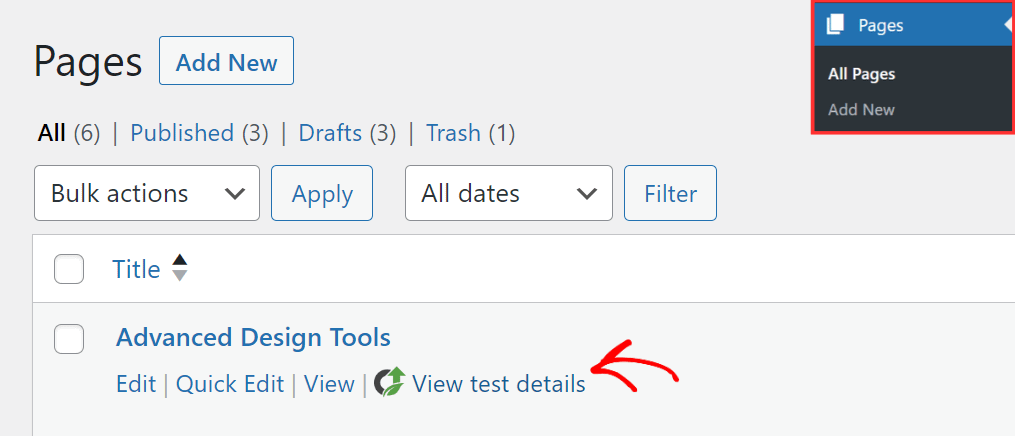
When you click View test details, you’ll be taken to a page with a graph showing the conversion rate comparison between variations.
You can decide the graph type, i.e., conversion rate or conversion, and the graph interval on the top right.

When you scroll further down, you’ll see a table with the list of variations, the traffic distribution, the total number of visits, unique visitors, the kind of goal, etc.

Stopping an A/B Test and Choosing a Winner Manually
Before selecting a winner manually, you must ensure you have disabled the automatic winner settings while creating an A/B test. If you’ve enabled Automatic Winner settings already, read further to know how you can disable it.
To view test details, open your WordPress admin area and navigate to Pages >> All Pages.
Under All Pages, hover on the page where you’ve added the test, and click the View Test Details link.

On the test details page, you can view the graph and table to see the performance of this A/B test.
If you’ve enabled Automatic Winner Settings, scroll down to the table on the A/B test details page and click the Change button beside Automatic Winner Settings Enabled.

After clicking the Change button, you’ll see a popup where you disable the automatic winner settings.
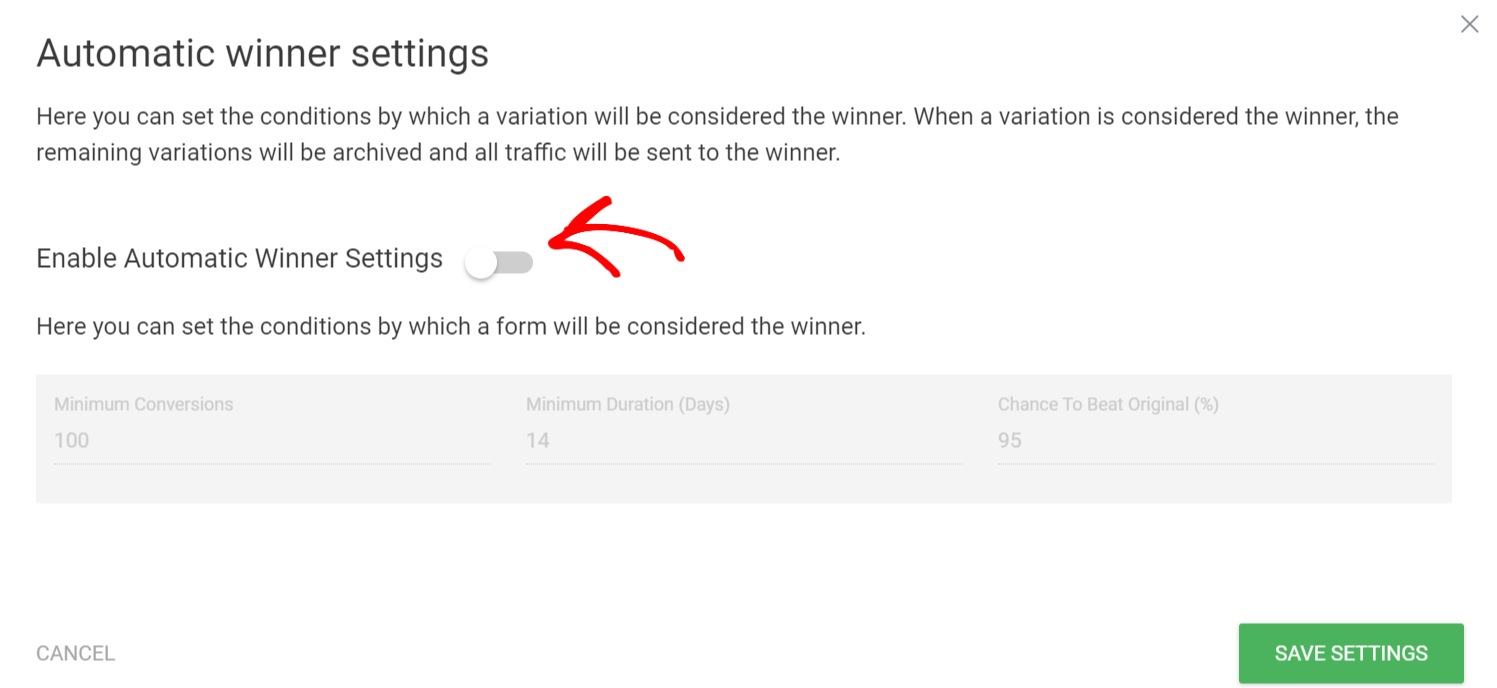
If you’ve not enabled the Automatic Winner Settings at the start, scroll down the View Test details page and click the Stop Test and Choose Winner button to select the A/B test winner.
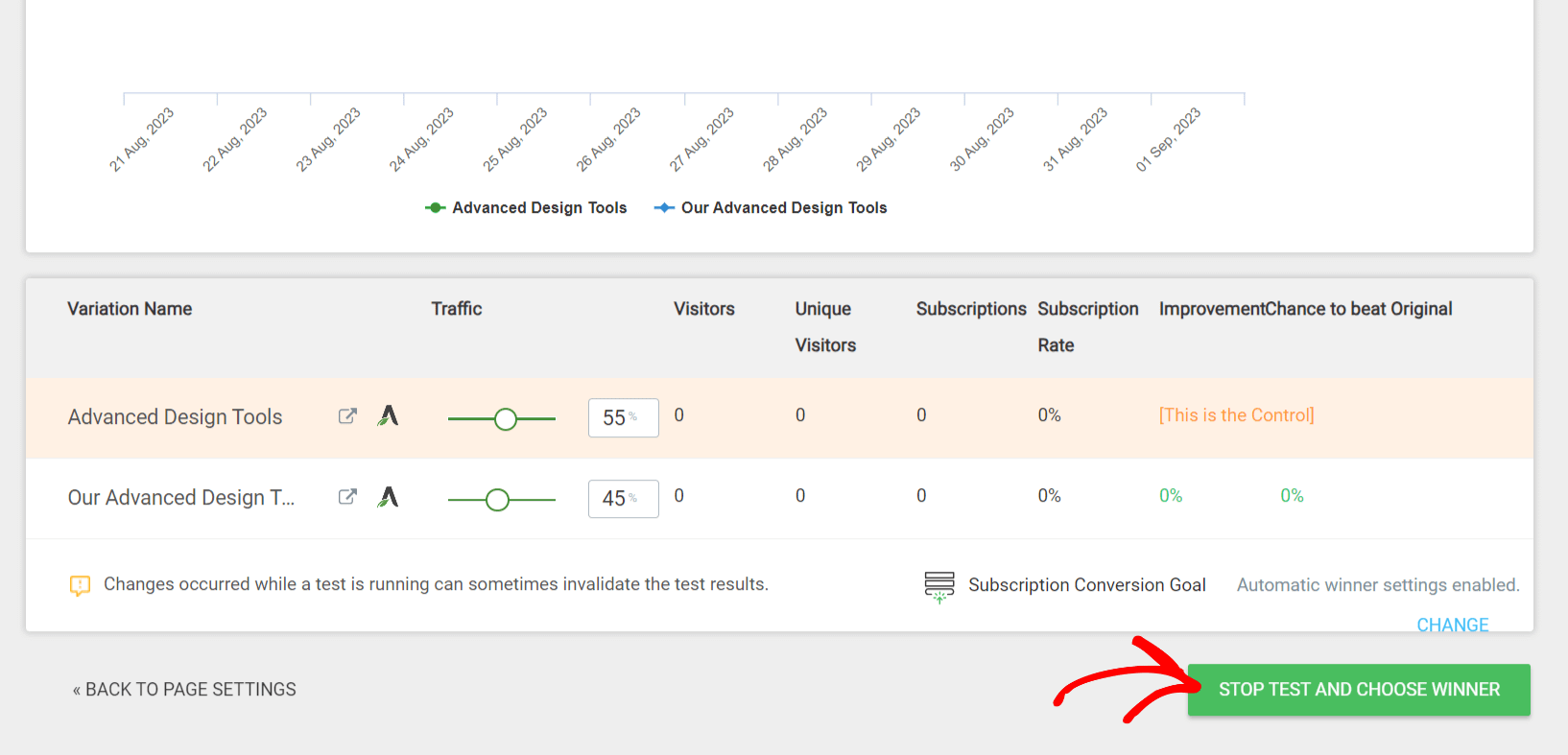
When you click the Stop test and choose the winner button, you’ll see a popup with statistics of the variations included in the test.
You can click the Set as Winner link beside the variation you want to declare as a winner.

Setting a winner will eliminate the other variation and keep only the winner variation on your website.
Frequently Asked Questions About Thrive Optimize:
Will creating multiple page variations for the A/B test slow down my website?
Like any other plugin, Thrive Optimize applies its logic to WordPress, but its use shouldn’t slow down your website.
Can I use Thrive Optimize with any WordPress theme?
Thrive Optimize is tested with various WordPress themes and works just fine. Should you come across an unexpected behavior while using any theme, please get in touch with us.
Will the A/B test reload each time the same user visits the page or reloads a page?
If the user visits the variation page for the first time, the plugin will remember the user as a “browser cookie,” and the next visit will show the same variation he got the first time. The user will be listed as a “cookie” for 30 days.
If the test runs after 30 days, the user will be considered any other random user and shown variations.
When a variation page is declared the winner, does it inherit the control page’s URL?
Yes, it does. The variation page only runs on one single URL.
Does Thrive Optimize work on blog posts?
No, Thrive Optimize was designed to work on Thrive Landing Pages only, but we extended it to normal pages, as well. In the near future, we could make Thrive Optimize work on many other posts, such as WooCommerce products, Thrive Quiz Builder quizzes, Thrive Ultimatum campaigns, etc.
Will the subscription goal work if I’m using HTML on my forms?
Yes, it will work. You need to use a Thrive Opt-in form that contains a Lead Generation element. This will work both with an API and an HTML connection.
Can I set traffic up for each page individually? (e.g., 70% to Page A and 30% to Page B)
Yes, you can. You can adjust the traffic separately for each page – The plugin will allow you to divide all the traffic (100%) into smaller parts, depending on how many variations you have set up.
Are Landing Pages in an A/B test slower than “normal” landing pages without a test?
It’s negligible. You will barely notice a difference, especially since Thrive Optimize is compatible with the most used caching plugins (W3 Total Cache, WP Rocket, WP Super Cache, and Autoptimize).
We recommend you disable the cache for the variations and the “Goal” pages if you use other caching plugins on your website.
How exactly are Thrive Optimize A/B testing counts being tracked? Is it via IP address? Via cookies? Via Referral links? Or a combination of those?
Cookies only. Many other tracking engines use their logic, which cannot be similar to ours, which only uses cookies.
Can I use Thrive Optimize to run tests on separate WordPress domains?
It can only be used on one website at a time. The test can be carried out on variations on a single website.
We’ve just seen how you can clone your website pages, A/B test them using Thrive Optimize, understand the Thrive Optimize dashboard, and much more.
Next, do you want to test two forms to see what works best? Here is a document that’ll help.